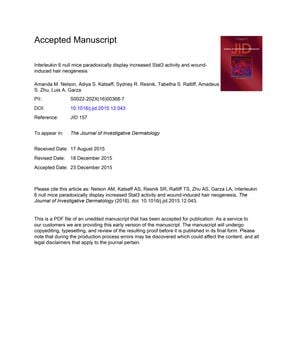Interleukin-6 Null Mice Paradoxically Display Increased STAT3 Activity and Wound-Induced Hair Neogenesis
January 2016
in “
Journal of Investigative Dermatology
”
IL-6 interleukin-6 IL-6 knockout IL-6 KO wild-type mice WT mice wound-induced hair neogenesis WIHN oncostatin M OSM interleukin 11 IL-11 phosphorylated Stat3 P-Stat3 Stat3 signaling cucurbitacin I JAK2/STAT3 hair follicle regeneration cytokine signaling ligand compensation hair neogenesis Stat3 hair regeneration

TLDR Mice without the IL-6 gene had more hair growth after injury due to higher activity of a related protein, Stat3.
The study found that IL-6 knockout (KO) mice exhibited a surprising 2-fold increase in wound-induced hair neogenesis (WIHN) compared to wild-type (WT) mice, despite the initial expectation that IL-6 absence would reduce WIHN. This unexpected result was attributed to elevated levels of other IL-6-type cytokines like oncostatin M (OSM) and interleukin 11 (IL-11) in the IL-6 KO mice, which may compensate for the lack of IL-6. Additionally, IL-6 KO mice showed a 10-fold increase in baseline phosphorylated Stat3 (P-Stat3) levels, indicating enhanced Stat3 signaling. The application of cucurbitacin I, which inhibits JAK2/STAT3, led to a reduction in hair follicle regeneration in IL-6 KO mice, underscoring the role of Stat3 in WIHN. The study concluded that the absence of IL-6 triggers a compensatory mechanism that increases Stat3 activation, essential for hair regeneration, demonstrating the complexity of cytokine signaling and ligand compensation.






